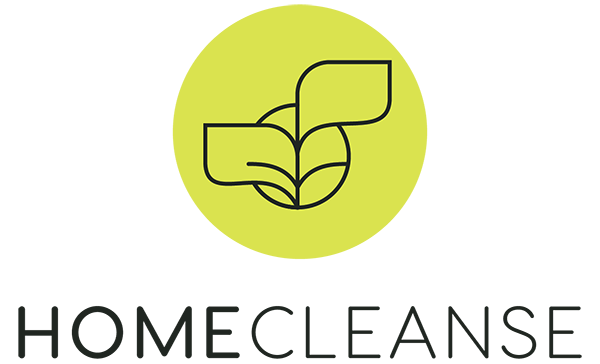Let’s face it—our bathrooms are busy, bustling spaces. From morning routines to relaxing bubble baths, they serve as the backdrop to our daily self-care rituals. But with all that water usage and humidity, it's no surprise these rooms are prime real estate for microbial growth. Mold in the bathroom is more than just an eyesore; it can affect the air we breathe, our health, and the overall feel of our home.
So, what can you do to keep this essential space healthy? You’ve come to the right place! Here’s your go-to guide for preventing mold in the bathroom—because a clean bathroom means a healthier home that supports your wellness!
How to Prevent Mold in the Bathroom: 12 Simple Steps
Here are 12 easy practices to prevent mold in the bathroom.
Fix Leaks Fast to Prevent Mold in the Bathroom
Leaky pipes or faucets may seem like minor problems, but they create the perfect environment for mold to thrive. The moisture from these leaks can allow mold in the bathroom to grow in as little as 24-48 hours.
Keep an eye out for leaks under sinks, around toilets, and along the shower area. If you spot one, fix it right away, dry the area thoroughly, and make sure everything stays sealed and dry.
Let the Air Flow to Prevent Mold in the Bathroom

Bathrooms are naturally humid, especially after a hot shower. High humidity levels, 60% and above, promote mold growth in the bathroom, so creating good airflow is essential.
Crack a window or open a door and turn on the exhaust fan during your shower. Make sure to leave the fan running for at least 30 minutes afterward to help air out the room. If your bathroom's humidity remains high, consider using a dehumidifier.
Bonus Tip: Make sure the exhaust fan is the right size for the space and in the correct location. If it's not or there is no exhaust fan in the bathroom, add this to your home improvement list for healthier indoor air quality!
Inspect Your Toilet Tank for Mold
Mold in the bathroom can pop up in places you don’t pay a lot of attention to… like the toilet tank.
If you spot mold in this area, it could be a sign that there’s a serious problem. Even though the toilet lid isn’t airtight, the air transfer between the inside and outside of the tank is quite limited. This creates an ideal environment for mold to grow, especially when moisture is present. While a stray spore can make its way in, it’s much more likely that high levels of mold spores in the air found their way into the tank, setting up camp and thriving in this damp area.
Check the tank regularly to ensure it's clean and to catch any problems early.
Learn more in this blog: Life Hack: This is What Mold in the Toilet Means.
Clean Often to Avoid Particle Build-Up
We all know cleaning isn't always fun, but regular cleaning can keep mold at bay in the bathroom. Dust, dirt, and grime can contribute to mold growth, so vacuum, mop, and wipe down surfaces weekly using a HEPA vacuum, microfiber towels, and botanical cleaners to tackle those invisible particles.
Tackle Grout and Caulk to Stop Mold in the Bathroom
Grout and caulk are porous, making them an ideal place for mold to take hold. Use hydrogen peroxide to clean these areas. It penetrates the surface to lift mold spores, making it easier to wipe them away with a microfiber cloth. Regular cleaning will keep your bathroom clean and free from contaminants.
Fix Structural Issues Immediately to Prevent Mold
Cracked tiles, loose grout, or damaged caulk can create moisture buildup, which invites mold to grow in the bathroom. Remember, all it takes is 24-48 hours on a wet surface for a mold spore to start growing.
If you notice any issues with your shower or bathtub, repair immediately to prevent mold from taking root.
Don’t Forget the Showerhead

Over time, showerheads can accumulate mineral buildup and mold. Give yours a deep clean at least once a month. Also, wipe it down daily with a microfiber cloth to prevent bacteria and mold from taking hold with the moisture present on the surface.
Keep Toothbrushes Dry
If not properly cared for, your toothbrush can become a breeding ground for bacteria and mold. Store your toothbrush in a well-ventilated spot, rinse it thoroughly after use, and make sure it dries completely. Clean it weekly to prevent any buildup.
Read this blog for more information on protecting your health:
A Moldy Toothbrush? Not Quite What The Dentist Recommended
Dry Towels and Bath Mats Properly to Prevent Mold in the Bathroom
Wet towels, bath mats, and wash rags are moisture harborers and mold magnets. Hang them up to dry immediately after use, allowing air to circulate and moisture to escape. This helps prevent mold from settling in on your fabrics.
Use Botanical Laundry Additives to Combat Mold in Bathroom Fabrics
Washing towels, bath mats, and other bathroom fabrics with a botanical laundry additive can help prevent mold growth. These natural products life mold spores and other particles from the surface so that they can be washed away, ensuring your linens stay clean and fresh.
Separate the Shower Curtain and Liner to Prevent Moisture
The combination of constant moisture and minimal airflow makes shower curtains and liners prime locations for mold growth. After showering, separate the curtain and liner so they can dry properly. This simple step can help keep mold at bay in your shower.
Keep Makeup Out of the Bathroom
Your beauty products may be more susceptible to mold than you think. Bathrooms are high-moisture areas, and that moisture, combined with the ingredients in your makeup, can create an environment where mold can grow.
Keep your makeup products in a dry, cool place outside the bathroom to prevent contamination.
What If Mold Shows Up Anyway?

Despite our best efforts, mold can sometimes sneak in. If you do encounter it, don’t panic—address the issue swiftly and correctly to minimize the health risks. With knowledge comes power!
Here’s what you need to know about handling mold in the bathroom:
To properly remediate mold, you’ve got to tick off three boxes:
- Remediate the sources properly.
- Identify and address the problems that led to those sources in the first place.
- Eradicate all contamination created by those sources, including spores, toxins, roots, fragments, and bacteria.
If any of these steps are skipped, the problem could resurface. Failing to address the root cause leaves the conditions for mold growth intact, while leaving behind mold roots or high levels of toxins can lead to ongoing exposure.
Here’s a breakdown of the steps to take:
Small Issues with Mold in the Bathroom
For minor contamination (under 10 square feet), you may be able to handle it yourself, but remember that some areas, like bathroom ceilings, can be tricky. Porous materials like drywall and insulation must be removed and replaced since it’s nearly impossible to clean them fully. Plus, it's tough to determine how far the contamination has spread.
With that in mind, your first step will be to assess the type of surface affected by the mold. This will dictate your remediation process.
The three surface types are:
- Porous: Liquid absorbs into the surface, like towels, clothing, or carpet.
- Non-porous: Liquid pools on top, like finished wood, sealed countertops, or glass.
- Semi-porous: Liquid pools slightly but is absorbed over time, like hardwood floors.
For non-porous surfaces (like metal), use a botanical cleaner such as Benefect Decon 30. Spray it on the surface, let it sit for 30 seconds, and then wipe it down with a microfiber cloth. Microfiber is far more effective at capturing small particles. Repeat the process two more times, giving the product 30 seconds of dwell time to ensure all particles, like mycotoxins, are removed.
For semi-porous surfaces (like hardwood), you’ll need a more abrasive method to remove the roots, which can grow into the surface and re-establish contamination. Combine this abrasive method with the process outlined for non-porous surfaces to eliminate the contamination on the surface.
After thoroughly removing particles, seal the surface so that mold will be less likely to return.
Remember, as the EPA notes, even dead mold can trigger health reactions, so it’s important to be thorough. Avoid using bleach, which is ineffective and can worsen the problem.
For porous items (like bath mats), it’s safest to dispose of them. The fibrous nature makes it nearly impossible to remove all contamination effectively.
During the remediation process, particles will become airborne. Make sure to set up containment areas, use personal protective equipment, and establish proper engineering controls to keep your home and health safe.
After remediation, give the surrounding area a deep clean to remove any spores or toxins released during the process.
-
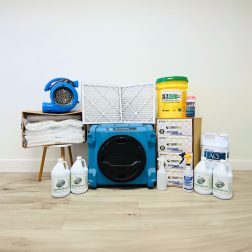
HomeCleanse DIY
All the equipment and materials we use to remediate your home, plus consultation and support...
-
$5,995.00 – $9,995.00 SHOP NOW -
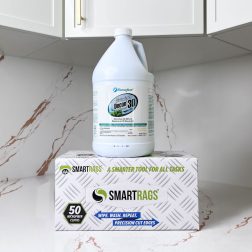
Mold & Bacteria Contents Cleaning
Remove harmful pollutants that accumulate in the dust of your home. (Options available for renters...
-
$99.00 – $349.00 SHOP NOW
Larger Issues with Mold in the Bathroom
You’ll need a qualified mold inspector to guide the process for larger-scale contamination. The inspector will gather crucial data to develop a remediation plan, ensuring that all factors—like mold species, quantities, spores in the HVAC system, and the presence of mycotoxins—are addressed.
This inspection should take a few hours, cover both the interior and exterior of the home, and use a variety of testing techniques.
Once you have this data, you’ll need a professional remediation team. It’s essential to choose a team that prioritizes health and has a track record of handling toxic environments effectively. Their remediation plan should follow the three steps outlined above to ensure a successful outcome.
For a safe and lasting remediation process, it's critical to address all aspects of mold contamination, from the sources to the complete removal of particles. Make sure you have the right experts on your side every step of the way.
Schedule a free 15-minute consultation with HomeCleanse to ensure you’re properly handling any contamination issue, like mold in the bathroom.
Prevent Mold in the Bathroom With This Checklist
Here’s a checklist to help keep your bathroom in tip-top shape!
✅ Daily Routine ✅
Keeping moisture levels in check starts with daily habits that can make a big difference in preventing mold and maintaining good air quality:
- Wipe down counters to prevent buildup of moisture and soap scum.
- Squeegee shower walls to remove excess water after each use.
- Rinse your toothbrush and thoroughly dry it to avoid mold growth in damp bristles.
- Create airflow by cracking a window or using a fan to keep air moving.
- Hang up towels, bath mats, wash rags, and loofas so they can dry thoroughly and prevent dampness.
- Separate the shower curtain and liner after use to allow them to dry and avoid trapped moisture.
✅ Weekly Tasks ✅
Once a week, it’s time to take a deeper dive into your bathroom’s upkeep:
- Dust baseboards to remove any potential dust buildup.
- Launder hand towels, bathmats, and towels using a botanical laundry additive to prevent microbial growth.
- Dust light fixtures and furniture that can trap moisture and mold spores.
- Vacuum and mop the floor to remove dirt and dampness.
- Sanitize surfaces using EPA-approved botanical cleaning products and microfiber towels.
- Check the toilet tank for mold—this often-overlooked area can harbor mold due to moisture.
- Inspect for leaks, water damage, or mold growth in hidden areas.
✅ Monthly Tasks ✅
At least once a month, focus on the areas that need a more thorough cleaning:
- Clean the shower curtain and liner to prevent soap scum buildup and mildew.
- Clean and reorganize cabinets—less clutter means fewer places for moisture to accumulate.
- Cleanse grout and caulk to prevent mold from forming in these porous surfaces.
- Deep clean the showerhead to remove mineral deposits and bacteria.
- Check for any structural issues that could trap moisture and encourage microbial growth.
✅ Seasonal Tasks ✅
Every few months, perform more extensive maintenance to keep your bathroom in top shape:
- Clean the exhaust fan to ensure it’s properly ventilating moist air.
- Replace the shower liner if it’s become moldy or worn.
- Replace the toothbrush or electric toothbrush head to maintain cleanliness.
Maintaining Your Peace of Mind Space

Mold in the bathroom might feel inevitable, but with the right strategies in place, you can help keep this unwelcome guest out of your home. By staying on top of leaks, controlling moisture levels, and regularly cleaning, you’ll create a healthier bathroom that supports your well-being. And if a problem pops up, you’ll know just how to fix it!
Plus, a mold-free bathroom means no more worrying about harmful air quality—it’s all about creating a space where you can truly relax and enjoy your time. So, grab that microfiber cloth and start ticking off these steps today—your bathroom (and your health) will thank you!
Must-Have Indoor Air Quality Tools
-
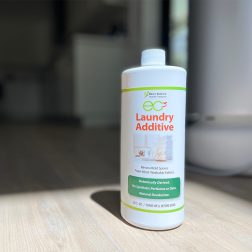
EC3 Laundry Additive
Add EC3 to every rinse cycle to rinse away mold, bacteria and musty odors from...
-
$23.00 SHOP NOW -
Sale
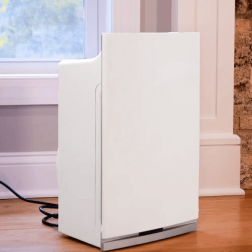
Intellipure Compact Air Purifier
Buy one Compact, get one free. Simply add one to your cart, and a second...
-
Original price was: $299.00.$199.00Current price is: $199.00. SHOP NOW -
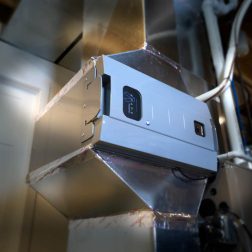
Intellipure SuperV Whole House Air Purifier
Turn your HVAC into a filtration system, removing 99% of ultrafine particles including airborne mold,...
-
$2,000.00 – $2,995.00 SHOP NOW -
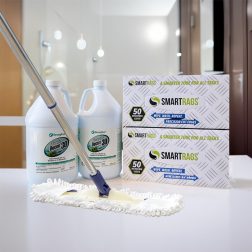
HomeCleanse Cleaning
Take your cleaning to the next level buying all the tools we use to keep...
-
$299.00 – $549.00 SHOP NOW -

Mold & Bacteria Contents Cleaning
Remove harmful pollutants that accumulate in the dust of your home. (Options available for renters...
-
$99.00 – $349.00 SHOP NOW -

EC3 Mold Solution Concentrate
Micro Balance EC3 Mold Solution Concentrate is a natural botanical that removes mold spores, bacteria,...
-
$33.00 SHOP NOW -
Sale

Industry-Leading Intellipure Ultrafine 468
The Intellipure® Ultrafine 468 features our proprietary DFS technology, which traps and eliminates potentially harmful...
-
Original price was: $999.00.$499.00Current price is: $499.00. SHOP NOW -
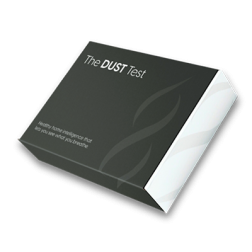
The Dust Test
The Dust Test is a comprehensive at-home test that helps you identify mold and toxins...
-
$274.00 SHOP NOW -
Sale
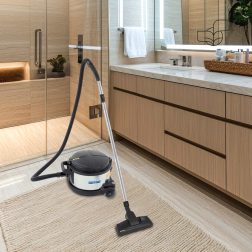
EuroClean 4 Gallon Hepa Vacuum
The Euroclean GD930HSP is a 4 Gallon Dry HEPA Vacuum that meets the EPA's standards...
-
Original price was: $849.00.$619.00Current price is: $619.00. SHOP NOW -
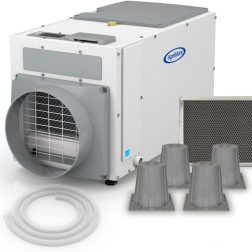
AprilAire E080 Professional Dehumidifier Bundle
Includes all the dehumidifier accessories you will need. Our Aprilaire E080 comes with a drain...
-
$1,499.99 SHOP NOW
